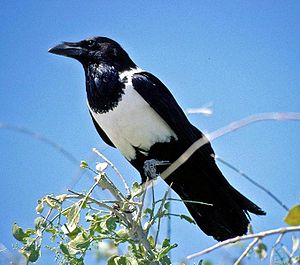Tortoiseshell
| Tortoiseshell | ||||||||||||
|---|---|---|---|---|---|---|---|---|---|---|---|---|

Tortoiseshell ( Corvus albus ) |
||||||||||||
| Systematics | ||||||||||||
|
||||||||||||
| Scientific name | ||||||||||||
| Corvus albus | ||||||||||||
| Statius Müller , 1776 |
The turtle ( Corvus albus ) is the most widespread raven bird in Africa . It owes its German and its scientific name to the shield- shaped white (Latin albus ) chest and neck area.
Appearance
With a body length of 45–53 cm, the tortoise- shell raven is slightly larger than the rook , a common raven bird in Europe. The plumage is shiny black except for the white chest, shoulders and the white collar. The bill and feet are also black. His call is described as a hoarse " ar-ar-ar-ar " or " karh-karh-karh ".
distribution
The tortoiseshell is distributed from Senegal , Sudan , northern Ethiopia and Somalia to the Cape (with the exception of eastern Namibia and southern Botswana ); on the island of Bioko in the Gulf of Guinea , as well as on some islands off the east coast of Africa ( Zanzibar , Pemba , Comoros , Aldabra , Assomption and Madagascar ). It is the only raven bird in Madagascar. The photo above right was taken in the Etosha National Park in Namibia.
habitat
The tortoiseshell prefers open terrain to forest areas; it can be found on the shores of inland waterways, on sea coasts and in cultivated landscapes and often seeks proximity to human settlements.
You can find him at heights of up to 4500 m, for example on Kilimanjaro .
food
In addition to carrion , the tortoiseshell also finds its live prey mainly on the ground: insects and other invertebrates , smaller reptiles and mammals as well as young birds - the latter it also prey occasionally in flight. There are reports that tortoiseshells have killed and ate sleeping fruit bats. Eggs from the clutches of other birds are also on his menu.
In human settlements he searches for waste, in grain fields he pokes at fresh seeds or ripe grain. He avoids contact with people. Shield ravens are regularly observed - sometimes in large numbers - as they search the vicinity of slaughterhouses for anything that can be used.
Breeding behavior
The tortoiseshell builds a large nest from natural materials such as rice or grass, preferably in tall, free-standing trees or on telegraph poles, but it also uses rags. The pale greenish, brown speckled four to five eggs are laid between September and November, depending on the latitude . The breeding season is 18–19 days; the eggs are covered with nesting material when the brooding female leaves the nest. The nestling period (the time from hatching to the fledgling of the young) is around 45 days. Both sexes are involved in raising the young.
literature
- Hans E. Wolters: The bird species of the earth . Paul Parey, Hamburg and Berlin, 1982, ISBN 3-490-09118-3 (for distribution)
- Th. Barlow and W. Wisniewski: Kosmos Nature Travel Guide - Southern Africa . Franckh-Kosmos, Stuttgart, 1998, ISBN 3-440-07665-2
Web links
- Corvus albus in the endangered Red List species the IUCN 2008. Posted by: BirdLife International, 2008. Accessed January 31 of 2009.
- Videos, photos and sound recordings on Corvus albus in the Internet Bird Collection
- Photo: aerial view from the side
- Three photo pages with 33 pictures
- The tortoise as a stamp motif in Madagascar and Tanzania

